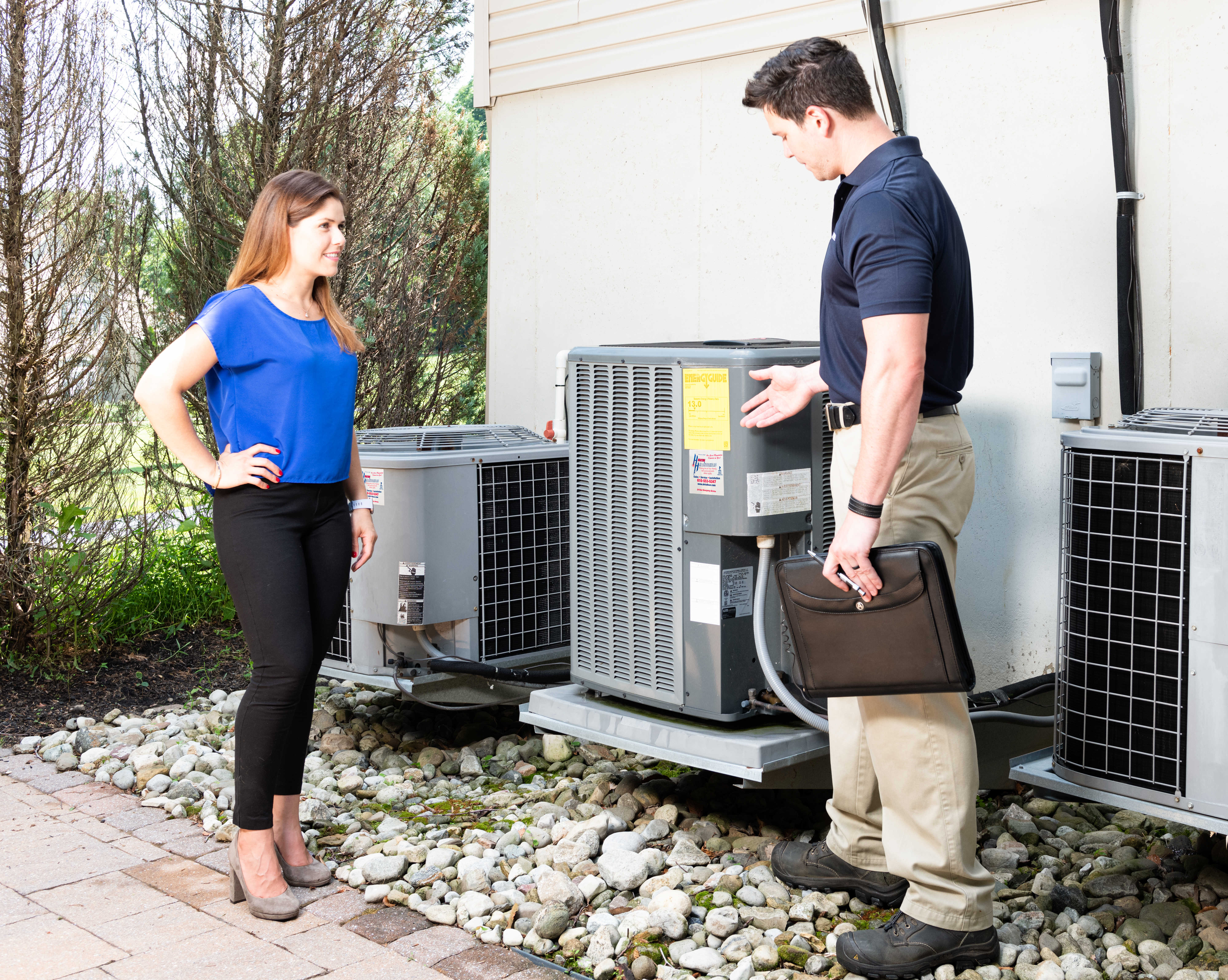Choose the right air conditioner with confidence. This guide covers sizing, efficiency ratings (SEER2/EER2), system types, comfort features, installation best practices, costs, rebates, and FAQs—tailored for homeowners across the Greater Toronto Area (GTA).

Quick Highlights (top of page)
-
Right-size first: Room-by-room Manual J load calculation beats rule-of-thumb sizing
-
Efficiency that matters: Look for SEER2/EER2 improvements for lower energy bills and better dehumidification
-
Comfort tech: Inverter or two-stage compressors + variable-speed blowers
-
Quiet operation: Check outdoor sound ratings (dB[A]) and indoor blower profiles
-
Air quality: MERV 8–13 filtration, sealed ducts, and proper condensate control
-
Smart controls: ecobee and similar thermostats boost comfort and savings
-
Pro install: Permits, commissioning, and refrigerant best practices protect performance and warranty
System Types (At a Glance)
-
Ducted Central AC
Works with your furnace/air handler and existing ductwork to deliver whole-home comfort. Ideal if ducts are in good shape and you want a single thermostat for the house. -
Ductless Mini-Splits (Single/Multi-Zone)
Great for homes without ducts, additions, top floors, and hot/cold rooms. Whisper-quiet indoor heads with individual room control and excellent efficiency. -
Considering Heating Too?
If you also need efficient heating, a heat pump can replace a traditional AC while providing year-round comfort.

Correct capacity prevents short-cycling, humidity issues, and high bills. We perform a Manual J heat-gain analysis considering insulation, windows, orientation, and occupancy. We also measure static pressure and assess supply/return ducts to ensure your new AC can move the right amount of air—quietly.
-
SEER2: Seasonal efficiency across a range of conditions; higher SEER2 = less energy used over a season.
-
EER2: Efficiency at a specific high-temperature test; helpful for peak-day performance comparisons.
-
Real-world results depend on duct design, airflow, charge accuracy, and thermostat settings—installation quality is everything.
-
Compressor Type
-
Single-Stage: Lowest cost; full on/off—adequate for smaller spaces.
-
Two-Stage: Runs on low most of the time for steadier temps and better humidity control.
-
Inverter/Variable-Capacity: Continuously modulates output for top comfort, lowest energy use, and quiet operation.
-
-
Blower Motor
-
PSC: Basic; higher power draw.
-
ECM/Variable-Speed: Quieter, more efficient, better filtration and humidity control.
-
-
Noise
Check outdoor unit dB(A) ratings and ask about sound blankets, fan design, and vibration isolation. -
Dehumidification
Longer, lower-speed cycles (two-stage/inverter) remove more moisture, improving comfort at higher setpoints.
-
Filters: Choose MERV 8–13 based on allergies, pets, and sensitivity.
-
Media Cabinets (4–5″): High surface area = better capture with lower pressure drop—ideal with variable-speed blowers.
-
Coil Cleanliness: Good filtration and routine service keep the evaporator coil clean, preserving capacity and efficiency.
-
Fresh Air: HRV/ERV systems bring in filtered outdoor air to reduce stuffiness.
-
Duct & Airflow Verification: Static-pressure test, proper return air, sealed transitions.
-
Refrigerant Piping: Nitrogen purge while brazing, pressure test, and deep vacuum ≤ 500 microns.
-
Charge Accuracy: Factory weigh-in plus superheat/subcool verification.
-
Condensate Management: Traps, slope, safety float switches, and—if needed—condensate pumps.
-
Electrical & Controls: Dedicated circuit, code-compliant disconnect, thermostat calibration/integration.
-
Commissioning: Documented temperature drop across the coil, airflow, and control logic.
-
Owner Walkthrough: Filter access, app setup, and maintenance schedule.
-
Good: High-efficiency two-stage AC, ECM blower, basic sound reduction
-
Best for: Solid comfort upgrade over builder-grade systems
-
-
Better: Inverter AC with higher SEER2/EER2, ultra-quiet outdoor unit, improved humidity control
-
Best for: Lower bills, steadier temperatures, quieter operation
-
-
Best: Premium variable-capacity AC with advanced dehumidification, low sound, and smart thermostat bundle
-
Best for: Maximum comfort, efficiency, and noise reduction
-
(Model availability and features vary; we provide multiple options at your quote.)
Compare purchase + installation + energy + maintenance over 10–15 years. In many homes, an inverter system pays back in comfort and energy savings—especially when paired with smart controls and a media cabinet for better airflow and filtration.
-
System 10–15+ years old with frequent breakdowns
-
Uses R-22 or has major refrigerant issues
-
High humidity, poor comfort, or rising energy bills
We’ll provide a repair-vs-replace comparison with lifecycle costs, comfort gains, and eligible incentives.
High-efficiency ACs may qualify for manufacturer or utility incentives. We confirm eligibility, handle paperwork, and offer financing to keep upfront costs manageable.
-
Annual tune-ups: Coil cleaning, electrical checks, firmware updates, charge verification
-
Filter changes: 1″ every 60–90 days; 4–5″ media every 6–12 months (inspect at 6)
-
Outdoor clearance: Keep 18–24″ around the condenser; remove debris and lint for proper airflow
Add our Air Conditioner Protection Plan for annual tune-ups, priority service, repair discounts, and refrigerant/condensate checks.
Proudly serving the Greater Toronto Area (GTA) and surrounding communities. Contact us to confirm availability in your neighborhood.
- Air Conditioner Repair
- Replace Your Air Conditioner
- Rent an Air Conditioner
- Air Conditioner Buyer’s Guide
- Buy Filters
How do I know what size AC I need?
We run a Manual J heat-gain calculation and verify duct capacity/returns—no guesswork.
Is inverter worth the extra cost?
Usually yes. Inverters modulate capacity for quieter operation, better humidity control, and lower energy use.
Do I need new ducts?
Not always. Many homes benefit from added return air, sealing, or transitions to meet airflow/noise targets.
Will a high-MERV filter restrict airflow?
It can. Use a 4–5″ media cabinet and variable-speed blower to achieve high filtration with low pressure drop.
What’s a good temperature drop across the coil?
Typical cooling delta is 16–22°F (9–12°C) under normal indoor humidity and correct airflow/charge.
Can I reuse my old line-set?
Sometimes. We flush or replace based on condition and manufacturer specs to protect the compressor and warranty.
Keep it running like new
Add our Air Conditioner Protection Plan for annual tune-ups, priority service, repair discounts, and refrigerant/condensate system checks. Preventive maintenance extends equipment life and keeps cooling efficiency high.
Ready for quieter, more efficient heat? Book your free in-home quote today.
- Phone: (905) 895-7787
- Email Us: Send Email
- Service Area: Greater Toronto Area
At Coffee Heating and Air Conditioning, we proudly offer a full spectrum of residential and commercial HVAC services across Toronto and the Greater Toronto Area. From expert installation of high-efficiency furnaces, air conditioners, boilers, and water heaters to precision repairs, emergency service calls, and routine system maintenance, our certified technicians ensure year-round comfort and safety for every client. We also specialize in air quality improvements, duct cleaning, smart thermostat integration, and energy-saving upgrades tailored to your home or business. Whether you’re building new, upgrading, or need fast repairs, our team delivers responsive, reliable solutions backed by industry expertise and a commitment to excellence.
